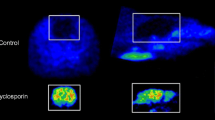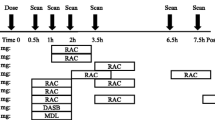Abstract
Serotoninergic type 2 (5HT2) receptors have been implicated in the regulation of many brain functions in humans and may play a role in several neurological and psychiatric diseases. Fluorine-18 altanserin has been proposed as a new radiotracer for the study of 5HT2 receptors by PET because of its high affinity for 5HT2 receptors (Ki: 0.13 nM) and its good specificity in in vitro studies. Dynamic PET studies were carried out in 12 healthy volunteers after intravenous injection of 0.1 mCi/kg [18F]altanserin. Ninety minutes after injection, we observed mainly cortical binding. Basal ganglia and cerebellum showed very low uptake and the frontal cortex to cerebellum ratio was about 3. To evaluate the quantitative distribution of this ligand in the brain, we used two different methods of data analysis: a four-compartment model was used to achieve quantitative evaluation of rate constants (K 1 and k 2 through k 6) by non-linear regression, and a multiple-time graphical analysis technique for reversible binding was employed for the measurement of k 1/k 2 and k 3/k 4 ratios. Using both methods, we found significant differences in binding capacity (estimated by k 3/k 4 = B max/K d) between regions, the values increasing as follows: occipital, limbic, parietal, frontal and temporal cortex. After correction of values obtained by the graphical method for the existence of non-specific binding, results generated by the two methods were consistent.
Similar content being viewed by others
References
Brown SL, Van Praag HM. The role of serotonin in psychiatric disorders. New York: Brunner/Mazel, 1991.
Kandel ER, Schwartz JH. Principles of neural science, 3rd edn. New York: Elsevier, 1991.
Schotte A, Maloteaux JM, Laduron PM. Characterization and regional distribution of serotonin S2-receptors in human brain. Brain Res 1983; 276: 231–235.
Pazos A, Probst A, Palacios JM. Serotonin receptors in the human brain. IV. Autoradiographic mapping of serotonin-2 receptors. Neuroscience 1987; 21: 123–139.
Wang DF, Wagner HN, Dannals RF, Links JM, Frost JJ, Ravert HT, Wilson AA, Rosenbaum AE, Gjedde A, Douglass KH, Petronis JD, Folstein MF, Toung JKT, Burns HD, Kuhar MJ. Effects of age on dopamine and serotonin receptors measured by positron tomography in the living human brain. Science 1984; 226: 1393–1396.
Nysberg S, Farde L, Eriksson L, Halldin C, Eriksson B. 5HT2 and D2 dopamine receptor occupancy in the living human brain: a PET study with risperidone. Psychopharmacology 1993, 110: 265–272.
Baron JC, Samson Y, Comar D, Crouzel C, Deniker P, Agid Y. Etude in vivo des récepeurs sérotoninergiques centraux chez l'homme par tomographie à positons. Rev Neurol (Paris) 1985;141:8–9:537–545.
Wong DF, Lever JR, Hartig PR, Dannals RF, Villemagne V, Hoffman BJ, Wilson AA, Ravert HT, Links JM, Scheffel U, Wagner HN. Localization of serotonin 5HT2 receptors in living human brain by positron emission tomography using N1-([11C]-methyl)-2-Br-LSD. Synapse 1987; 1: 393–398.
Frost JJ, Dannals RF, Mayberg HS, Links JM, Ravert HT, Kubar MJ, Wagner HN. Regional localization of serotonin-2 receptors in man using C- 11-N-Methylketanserin (NMKET) and PET [abstract]. J Nucl Med 1987; 28: 600
Blin J, Sette G, Morelli M, Bletry O, Elghozi JL, Crouzel C, Baron JC. A method for the in vivo investigation of the serotonergic 5HT2 receptors in the human cerebral cortex using positron emission tomography and 18H-labelled setoperone. J Neurochem 1990; 54: 1744–1754.
Leysen JE. Use of 5HT receptor agonists and antagonists for the characterization of their respective receptor sites. In: Boulton AB, Baker GB, Jurio AV (eds) Drugs as tools in neurotransmitter research (Neuromethods, vol 12). Clifton, N.J.: Humana Press; 1989: 299–349.
Lemaire C, Cantineau R, Guillaume M, Plenevaux A, Christiaens L. Fluorine-18-altanserin: a radioligand for the study of serotonin receptors with PET: radiolabeling and in vivo biologic behavior in rats. J Nucl Med 1991; 32: 2266–2272.
Sadzot B, Lemaire C, Cantineau R, Salmon E, Plenevaux A, Maquet P, Hermanne JP, Franck G, Guillaume M. Imaging serotonin-S2 receptors in humans with PET and the selective S2 antagonist fluorine- l8-altanserin [abstract]. J Nucl Med 1990;31: 1584.
Monclus M, Masson C, Luypaert PJ, Van Naemen J, Ledent E, Luxen A. Nucleophilic [F-18]radiofluorination using microwave cavity: application to fluorine [F-18]FDG and [F18]altanserin synthesis [abstract]. Eur J Nucl Med 1993; 20:1000.
Logan J, Fowler JS, Volkow ND, Wolf AP, Dewey SL, Schlyer DJ, MacGregor RR, Hitzemann R, Bendriem B, Gatley SJ, Christman DR. Graphical analysis of reversible radioligand binding from time-activity measurements applied to [N-11C-methyl]-(−)-cocaine PET studies in human subjects. J Cereb Blood Flow Metab 1990; 10: 740–747.
Monclus M, Luxen A. A convenient synthesis of (4-nitrophenyl)(4-piperidinyl) ketone. Org Prep Proced Int 1992; 24:692–694.
Monclus M, Biver F, Goldman S, Luxen A. [18F]altanserin: a short synthesis of the nitroprecursor and preliminary metabolic studies in rat. J Labelled Compd Radiopharm 1992; 31: 523–524.
Talairach J, Tournoux P. Co-planar stereotaxic atlas of the human brain-3-dimensional proportional system: an approach to cerebral imaging. New York: Thieme Medical, 1988.
Frost JJ, Douglass KH, Mayberg HS, Dannals RF, Links JM, Wilson AA, Ravert HT, Crozier WC, Wagner HN. Multicompartmental analysis of [11C]-carfentanil binding to opiate receptors in humans measured by positron emission tomography. J Cereb Blood Flow Metab 1989; 9: 398–409.
Hawkins RA, Phelps ME, Huang SC. Effects of temporal sampling, glucose metabolic rates, and disruptions of the blood-brain barrier on the FDG model with and without a vascular compartment: studies in human brain tumors with PET. J Cereb Blood Flow Metab 1986; 6: 170–183.
Marquardt DW. J Soc Ind Appl Math 1963; 11: 431–441.
Mintun MA, Raichle ME, Kilbourn MR, Wooten GF, Welch MJ. A quantitative model for the in vivo assessment of drug binding sites with positron emisson tomography. Ann Neurol 1984; 15: 217–227.
Wienhard K. Modelisation: application to the D2 receptors. In: Baron JC et al. (eds) Brain dopaminergic systems: imaging with positron tomography. Netherlands: Kluwer Academic; 1991:85–95.
Biver F, Goldman S, Monclus M, Luxen A, Lotstra F, Mendlewicz J. Autoradiographic study of [18F]altanserin in the rat: a potential radiotracer for 5HT2 receptor study with PET. Clin Neuropharmacol 1992; 15 Suppl 1, pt B: 202.
Author information
Authors and Affiliations
Rights and permissions
About this article
Cite this article
Biver, F., Goldman, S., Luxen, A. et al. Multicompartmental study of fluorine-18 altanserin binding to brain 5HT2 receptors in humans using positron emission tomography. Eur J Nucl Med 21, 937–946 (1994). https://doi.org/10.1007/BF00238117
Received:
Revised:
Issue Date:
DOI: https://doi.org/10.1007/BF00238117




